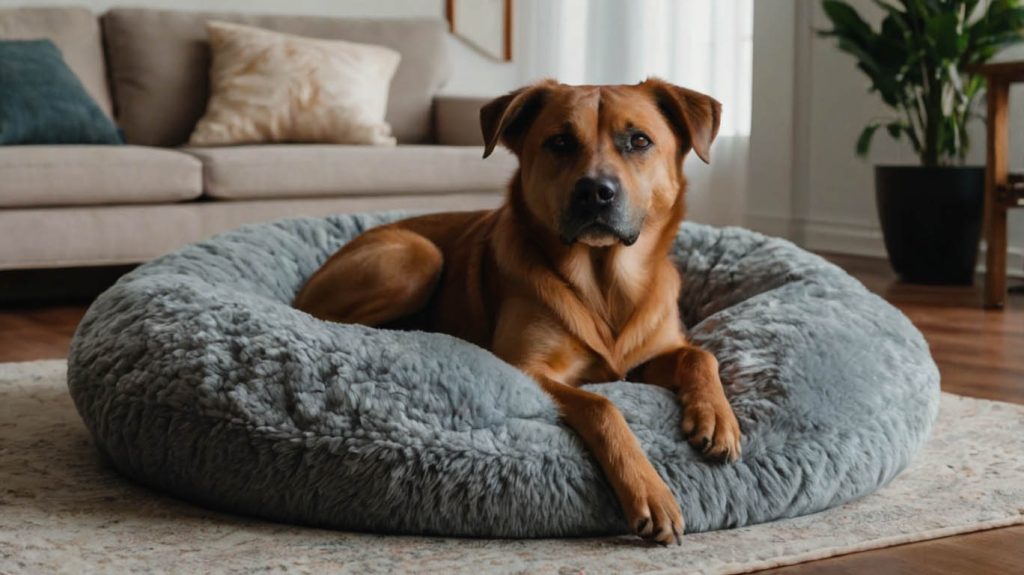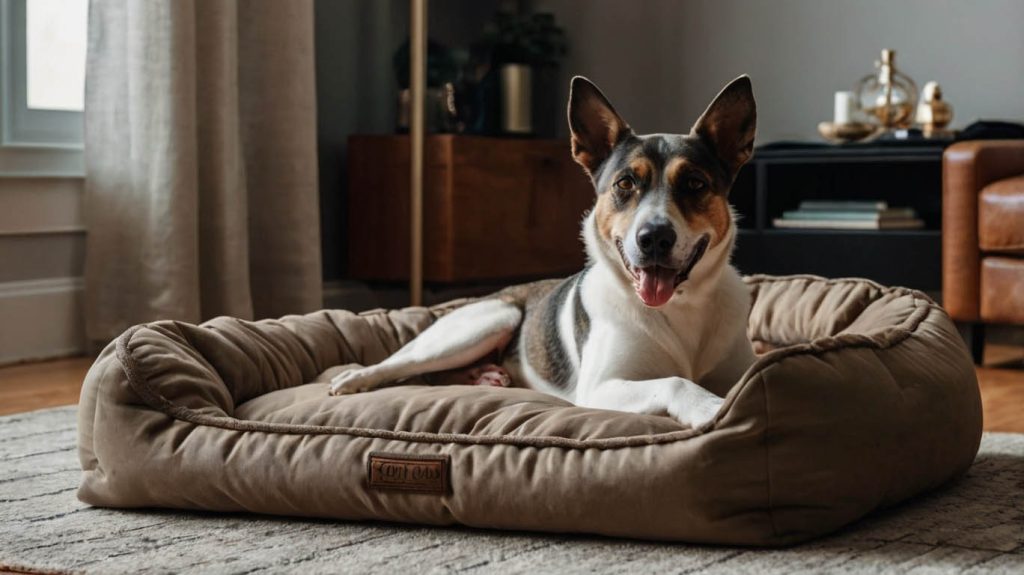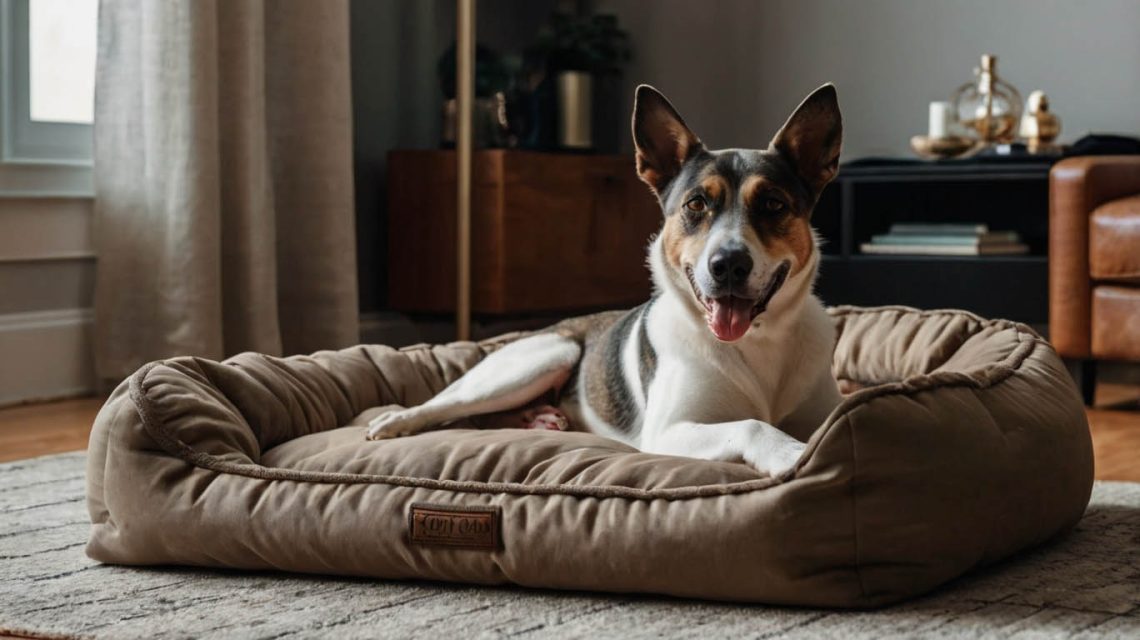Watching your loyal companion grow older is a bittersweet journey. To ensure their golden years are filled with comfort instead of pain, finding the best dog beds for older dogs is one of the most important investments you can make. Remember when your dog was a puppy, a boundless ball of energy, leaping onto the couch without a second thought? Now, as a cherished senior, those leaps might have turned into careful calculations. You may notice them hesitating before jumping, moving a little slower in the mornings, or choosing the softest spot on the rug. This is the story of a life well-lived, and consequently, it’s a story that deserves supreme comfort.
Your loyal companion has given you years of unwavering love. Therefore, providing them with a supportive and comfortable place to rest isn’t just a luxury; it’s an essential part of their senior healthcare. A proper bed can dramatically improve their quality of life, ease their aches, and ensure their golden years are truly golden.
This in-depth guide will walk you through everything you need to know. We’ll explore why a specialized bed is crucial, what features to look for, and how to choose the perfect one for your furry family member.
Why Finding the Best Dog Beds for Older Dogs is Crucial
As dogs age, their bodies change significantly, much like our own. The hard floor or a lumpy, unsupportive cushion no longer provides the relief they need. In fact, an inadequate bed can actually exacerbate their problems.
For instance, consider Max, a 12-year-old Golden Retriever who began showing signs of stiffness. His family noticed he was restless at night, constantly shifting positions on his old, flattened bed. As a result, his mobility during the day suffered. This is a common story. Senior dogs often face several health challenges that a proper bed can help alleviate:
- Arthritis and Joint Pain: This is one of the most common ailments in older dogs. An orthopedic bed distributes their weight evenly, which consequently reduces pressure on sore joints like hips, elbows, and shoulders.
- Hip Dysplasia: Breeds prone to this condition need firm, consistent support to keep their joints properly aligned and minimize pain.
- Loss of Muscle Mass: Seniors naturally lose muscle, meaning they have less natural padding. A supportive bed acts as a buffer between their bones and the hard floor.
- Improved Sleep Quality: Just like us, dogs need deep, restorative sleep to heal and recharge. A comfortable dog is a well-rested dog, leading to more energy and a better mood during the day.
Ultimately, investing in one of the best dog beds for older dogs is an investment in their happiness and mobility.

Key Features of the Best Dog Beds for Older Dogs
Navigating the market for dog beds can be overwhelming. However, by focusing on a few key features, you can easily narrow down the options and find the perfect match. When searching for the best dog beds for older dogs, prioritize these essential elements.
Orthopedic Support: The Core of the Best Beds for Senior Dogs
This is the most critical feature. But what does “orthopedic” truly mean? It’s not just a marketing term. A genuine orthopedic dog bed uses high-quality, supportive foam that conforms to your dog’s body while resisting flattening over time.
- Solid Memory Foam: Look for beds with a solid slab of high-density memory foam, at least 4 inches thick for medium to large breeds. This material, originally designed by NASA, cradles the body, relieves pressure points, and provides unparalleled support.
- Layered Foam: Some of the best dog beds for older dogs use a layered approach—a top layer of conforming memory foam over a base of firmer, high-density support foam. This combination prevents your dog from “sinking” all the way to the floor.
Avoid beds filled with loose cedar chips, cotton batting, or thin egg-crate foam, as they will compress quickly and offer little to no real joint support.
Easy-Access Design in Beds for Older Dogs
Aching joints make climbing a challenge. A bed that is too high or has tall, firm walls can be a barrier for a senior dog.
Therefore, look for a bed with a low profile or at least one side with a lowered entry point. This allows your dog to walk onto their bed with minimal effort, reducing the risk of pain or injury. Bolster-style beds can still be a great option; however, ensure the bolster doesn’t encircle the entire bed, providing a clear path for entry and exit.
The Importance of a Washable Cover and Waterproof Liner
Accidents happen, especially with senior dogs who may be experiencing incontinence or have more difficulty “holding it.” A bed that is difficult to clean will quickly become unhygienic and smelly.
For this reason, two features are non-negotiable:
- Removable, Machine-Washable Cover: This is an absolute must for easy cleaning of dirt, dander, and any minor spills.
- Waterproof Liner: This is the hidden hero. A waterproof liner fits around the foam core, underneath the outer cover. It protects the expensive foam from accidents, ensuring the bed remains sanitary and lasts for years. Without it, a single accident could ruin the entire bed.
A bed with both these features is undeniably one of the best dog beds for older dogs you can buy.

Top Types of Dog Beds for Older Dogs
With the key features in mind, let’s explore the most common and effective styles of beds available for your senior companion.
The Classic Orthopedic Mattress Bed for Older Dogs
This is often the top recommendation from veterinarians and the most popular choice for good reason. It’s a simple, flat mattress design made from a solid slab of high-quality orthopedic or memory foam.
- Pros: Maximum surface area for dogs who love to sprawl, easy to get on and off from any angle, and provides consistent, even support across the entire body.
- Cons: Lacks the “cuddling” security of a bolster bed.
- Best For: Most senior dogs, especially large breeds and those who like to stretch out completely. This style truly represents one of the best dog beds for older dogs.
Supportive Bolster Beds for Added Security for Older Dogs
Bolster beds feature raised, cushioned edges on three sides, with one side open for easy access. These “sofa-style” beds offer a sense of security and a built-in pillow.
- Pros: The bolsters provide a comfortable place for your dog to rest their head, promoting better spinal alignment. Additionally, they give a sense of security to dogs who like to feel snuggled or lean against something.
- Cons: Ensure the entry point is low and the bolsters aren’t too high for your dog to step over.
- Best For: Dogs who love to curl up, lean, or use a pillow. This is an excellent alternative if you’re looking for one of the best dog beds for older dogs with added comfort features.
Considering Heated or Cooling Beds for Older Dogs
Temperature regulation can also be a significant factor in your dog’s comfort.
- Heated Beds: Gentle, low-level heat can be incredibly soothing for arthritic joints, especially in colder climates. You should look for models with safety features like low voltage and automatic shut-offs.
- Cooling Beds: For dogs in warmer climates or breeds that overheat easily (like bulldogs or pugs), a cooling gel-infused memory foam bed can help them rest comfortably without panting.
How to Choose the Right Size and Style for Your Dog
Now that you understand the options, here’s a simple process to select the perfect bed.
- Observe Their Sleeping Style: First, does your dog curl into a tight ball or sprawl out like a superhero? A “curler” might prefer the security of a bolster bed, while a “sprawler” needs the space of a flat mattress bed.
- Measure Your Dog: Next, don’t just guess the size. Measure your dog from the tip of their nose to the base of their tail while they are in their typical sleeping position. Then, add 8-12 inches to this measurement to ensure they have plenty of room to stretch. This is a crucial step to finding the best dog beds for older dogs.
- Consider Their Weight: Finally, heavier dogs require thicker, denser foam to prevent them from sinking through to the floor. Most reputable manufacturers provide weight guidelines for their bed sizes.
Why the Best Dog Beds for Older Dogs Are a Worthy Investment
Before you make your final decision, run through this quick checklist. Does the bed have:
- At least 4 inches of solid, high-density orthopedic or memory foam?
- A low-profile or easy-access entry point?
- A removable and machine-washable cover?
- A protective waterproof liner for the foam core?
- A non-skid bottom to prevent slipping on hard floors?
- The right size and shape for your dog’s specific needs?
If you can check all these boxes, you have found one of the best dog beds for older dogs on the market.
Let’s go back to Max, the Golden Retriever. After realizing his old bed was part of the problem, his family invested in a large, orthopedic mattress-style bed with 5 inches of memory foam and a waterproof liner. The first night, Max slept soundly through until morning. Within a week, his family noticed he was getting up with more ease and seemed more eager for his morning walk. The change was remarkable.
This story isn’t unique. The right bed is a powerful tool for managing the comfort and health of your senior dog. It’s a tangible way to say “thank you” for a lifetime of companionship. You’re not just buying a bed; you’re providing relief, support, and the deep, restful sleep they need and deserve.
Ready to give your loyal companion the gift of comfort? Explore our curated collection of top-rated orthopedic dog beds. See the difference the right support can make and help your best friend enjoy their golden years to the fullest.


